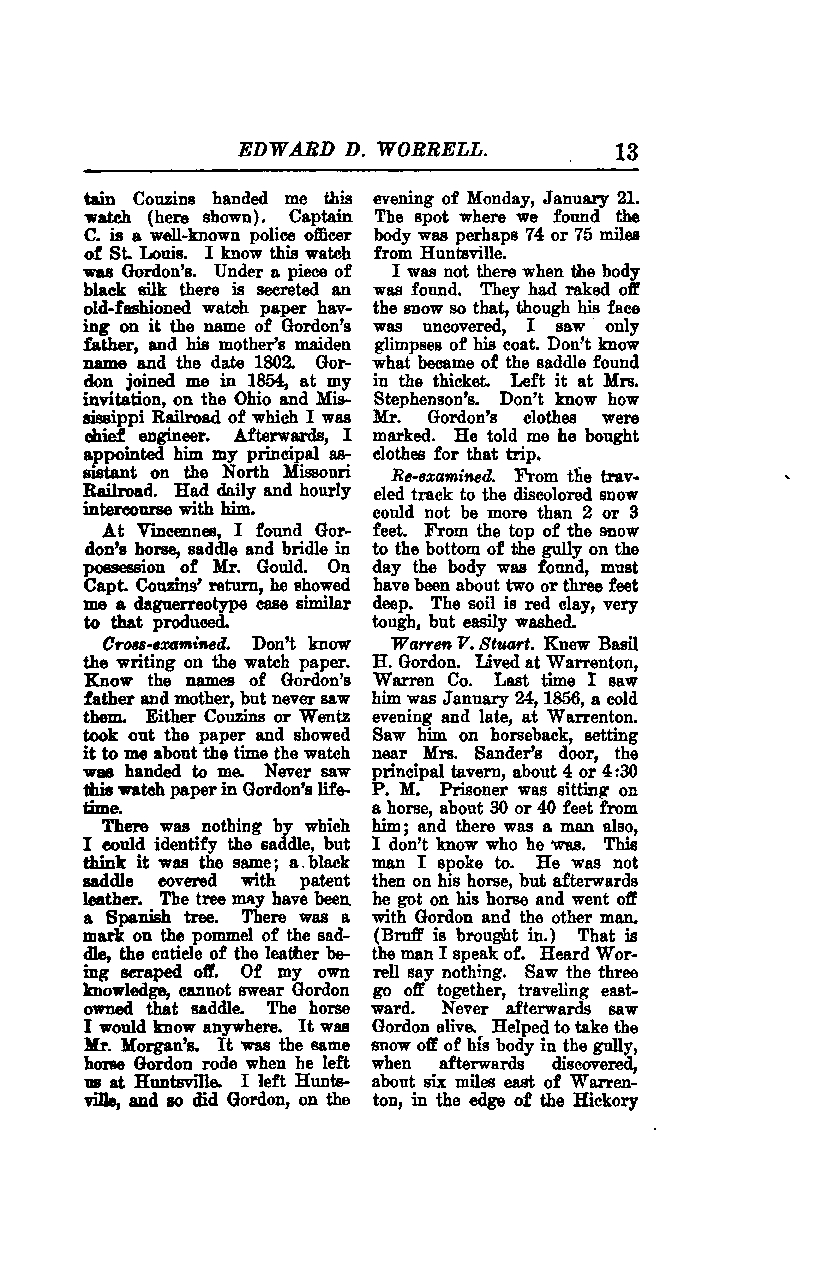Reading Time: 4 minutes [578 words]

Here is the translated text as follows:
EDWARD D. WOERRELL
Captain Couzins handed me this watch (here shown). Captain C. is a well-known police officer of St. Louis. I know this watch was Gordon's. Under a piece of black silk, there is secreted an old-fashioned watch paper having on it the name of Gordon's father, his mother's maiden name, and the date 1802. Gordon joined me in 1854, at my invitation, on the Ohio and Mississippi Railroad of which I was chief engineer. Afterwards, I appointed him my principal assistant on the North Missouri Railroad. I had daily and hourly intercourse with him.
At Vincennes, I found Gordon's horse, saddle, and bridle in possession of Mr. Gould. On Captain Couzins' return, he showed me a daguerreotype case similar to that produced.
**Cross-examined:** I don't know the writing on the watch paper. I know the names of Gordon's father and mother, but I never saw them. Either Couzins or Wentz took out the paper and showed it to me about the time the watch was handed to me. I never saw this watch paper in Gordon's lifetime.
There was nothing by which I could identify the saddle, but I think it was the same; a black saddle covered with patent leather. The tree may have been a Spanish tree. There was a mark on the pommel of the saddle, the cuticle of the leather being scraped off. Of my own knowledge, I cannot swear Gordon owned that saddle. The horse I would know anywhere. It was Mr. Morgan's. It was the same horse Gordon rode when he left us at Huntsville. I left Huntsville, and so did Gordon, on the evening of Monday, January 21. The spot where we found the body was perhaps 74 or 75 miles from Huntsville.
I was not there when the body was found. They had raked off the snow so that, though his face was uncovered, I saw only glimpses of his coat. I don't know what became of the saddle found in the thicket. I left it at Mrs. Stephenson's. I don't know how Mr. Gordon's clothes were marked. He told me he bought clothes for that trip.
**Re-examined:** From the traveled track to the discolored snow could not be more than 2 or 3 feet. From the top of the snow to the bottom of the gully on the day the body was found, it must have been about two or three feet deep. The soil is red clay, very tough, but easily washed.
**Warren V. Stuart:** I knew Basil H. Gordon. I lived at Warrenton, Warren County. The last time I saw him was January 24, 1856, a cold evening and late, at Warrenton. I saw him on horseback, sitting near Mrs. Sander's door, the principal tavern, about 4 or 4:30 P.M. The prisoner was sitting on a horse, about 30 or 40 feet from him; and there was another man also, I don't know who he was. I spoke to this man. He was not then on his horse, but afterwards he got on his horse and went off with Gordon and the other man. (Bruff is brought in.) That is the man I speak of. I heard Worrell say nothing. I saw the three go off together, traveling eastward. I never afterwards saw Gordon alive. I helped to take the snow off of his body in the gully when it was afterwards discovered, about six miles east of Warrenton, in the edge of the Hickory Grove.
---